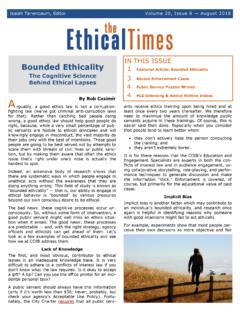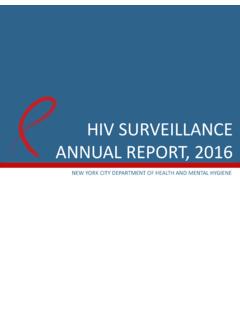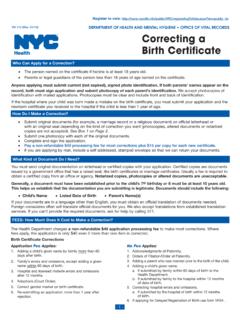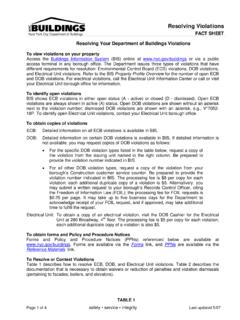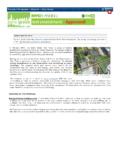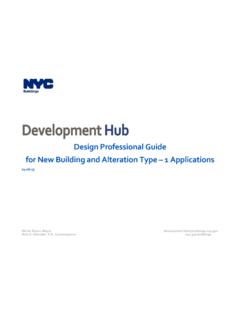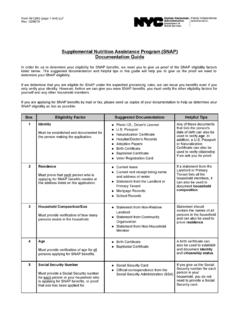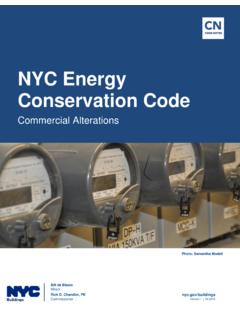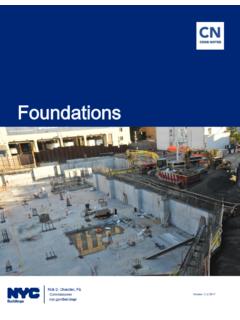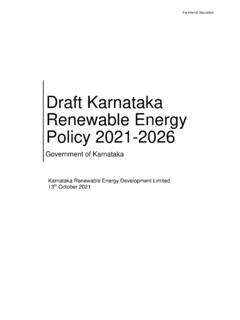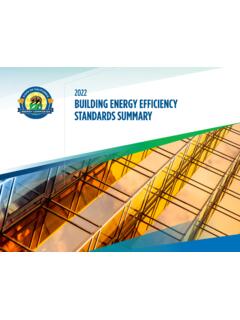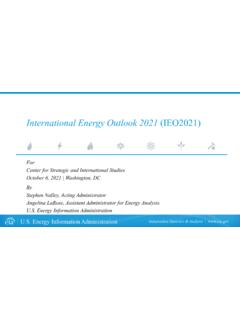Transcription of Local Law 97 of 2019 - New York City
1 Local LAWS OF THE city OF NEW york FOR THE YEAR 2019 _____ No. 97 _____ Introduced by Council Members Constantinides, The Speaker (Council Member Johnson) and Council Members Torres, Kallos, Rosenthal, Levin, Rivera, Koo, Powers, Levine, Reynoso, Richards, Salamanca, Menchaca, Chin, Lander, Ampry-Samuel, Ayala, Cumbo, Rose, Brannan, the Public Advocate (Mr. Williams), Espinal, Rodriguez, Lancman, Dromm, Gibson, Treyger, Cornegy, Van Bramer, Moya, Holden, Cohen, Eugene, Barron, Adams, Koslowitz, Cabrera and King. A Local LAW To amend the New york city charter and the administrative code of the city of New york , in relation to the commitment to achieve certain reductions in greenhouse gas emissions by 2050 Be it enacted by the Council as follows: Section 1. Chapter 26 of the New york city charter is amended by adding a new section 651 to read as follows: 651.
2 Office of building energy and emissions performance. a. There shall be in the department an office of building energy and emissions performance. The office shall be headed by a director, who is a registered design professional, who shall be appointed by and shall report to the commissioner. The duties of the office shall include, but not be limited to: 1. Overseeing implementation of building energy and emissions performance laws and policies for existing buildings, new construction and major renovations; 2. Establishing or administering protocols for assessing annual energy use in buildings; 3. Monitoring buildings energy use and emissions, and reviewing building emissions assessment methodologies, building emissions limits, goals and timeframes to further the goal of 2 achieving a 40 percent reduction in aggregate greenhouse gas emissions from covered buildings by calendar year 2030, relative to such emissions for the calendar year 2005; 4.
3 Creating an online portal for the submission of annual building emissions assessments by owners; 5. Receiving and validating annual building emissions assessments; 6. Auditing building emissions assessments and inspecting covered buildings, as necessary, to ensure proper reporting; 7. Determining recommended penalties, including minimum penalties, for buildings that are noncompliant with applicable emissions limits; 8. Reviewing applications for alternative methods of compliance with building emissions limits, including adjustments of emissions limits, deductions for the purchase of greenhouse gas offsets or renewable energy credits, deductions for the use of distributed energy resources, and adjustments for special categories of buildings or for special use and occupancies; 9. Working in close coordination with the mayor s office of long-term planning and sustainability; receiving advice and recommendations, as applicable, from the advisory board established pursuant to section of the administrative code; and 10.
4 Ensuring the participation and cooperation of agencies, including but not limited to the department of environmental protection, the department of housing preservation and development and the department of citywide administrative services. Such participation and cooperation shall include, but not be limited to, detailing agency staff to assist office staff consistent with agency and office functions and reporting to the office on building energy performance issues and related enforcement efforts. 3 2. Subdivision e of section 24-802 of the administrative code of the city of New york , as added by Local law number 22 for the year 2008, is amended to read as follows: e. " city government operations" means [operations described in the Government Inventory Methodology and the Government Inventory Results sections of the Inventory of New york city Greenhouse Gas Emissions, dated April 2007] operations, facilities, and other assets that are owned or leased by the city for which the city pays all or part of the annual energy bills.
5 3. Paragraph (1) of subdivision a of section 24-803 of the administrative code of the city of New york , as amended by Local law number 66 for the year 2014, is amended to read as follows: (1) Reduction of emissions citywide. There shall be, at minimum, a [thirty] 40 percent reduction in citywide emissions by calendar year 2030, and an [eighty] 80 percent reduction in citywide emissions by calendar year 2050, relative to such emissions for the base year for citywide emissions. 4. Subdivision b of section 24-803 of the administrative code of the city of New york , as added by Local law number 22 for the year 2008, is amended to read as follows: b. (1) Reduction of emissions from city government operations. There shall be, at minimum, a [thirty] 40 percent reduction in city government emissions by [calendar] fiscal year [2017] 2025, and a 50 percent reduction in city government emissions by calendar year 2030, relative to such emissions for the base year for city government emissions.
6 (2) The emissions reduction required by paragraph [one] 1 of this subdivision shall be achieved through the applicable policies, programs and actions included in PlaNYC, energy efficiency retrofits, and any additional policies, programs and actions to reduce greenhouse gas emissions that contribute to global warming, including methods to ensure equitable investment in environmental justice communities that preserve a minimum level of benefits for all communities 4 and do not result in any localized increases in pollution. If the office determines that such emissions reduction is not feasible despite the best efforts of city government operations, such office shall report such findings and make recommendations with respect to policies, programs and actions that may be undertaken to achieve such reductions.
7 (3) Reduction of emissions by the New york city housing authority. The New york city housing authority shall make efforts to reduce greenhouse gas emissions by 40 percent by the year 2030 and 80 percent by the year 2050, relative to such emissions for calendar year 2005, for the portfolio of buildings owned or operated by the New york city housing authority. If the office determines that such emissions reduction is not feasible despite the best efforts of city government operations, such office shall report such findings and make recommendations with respect to policies, programs and actions that may be undertaken to achieve such reductions. 5. Chapter 3 of title 28 of the administrative code of the city of New york is amended by adding a new article 320 to read as follows: ARTICLE 320 BUILDING ENERGY AND EMISSIONS LIMITS Definitions.
8 As used in this article, the following terms shall have the following meanings: BUILDING EMISSIONS. The term building emissions means greenhouse gas emissions as expressed in metric tons of carbon dioxide equivalent emitted as a result of operating a covered building and calculated in accordance with rules promulgated by the department in consultation with the mayor s office of long term planning and sustainability. The term building emissions shall not include greenhouse gas emissions emitted during a Local state of emergency declared by the mayor pursuant to section 24 of the executive law or a state of emergency declared by the governor pursuant to sections 28 of the executive law, where such Local or state emergency has an impact on building emissions. BUILDING EMISSIONS INTENSITY. The term building emissions intensity means, for a covered building, the number obtained by dividing the building emissions by the gross floor area for such building, expressed in metric tons of carbon dioxide equivalent per square foot per year.
9 5 CARBON DIOXIDE EQUIVALENT. The term carbon dioxide equivalent means the metric used to compare the emissions of various greenhouse gases based upon their global warming potential as defined in the Intergovernmental Panel on Climate Change Fifth Assessment Report (2014). city BUILDING. The term city building means a building that is owned by the city or for which the city regularly pays all of the annual energy bills. Exception: The term city building shall not include any senior college in the city university of New york system. CLEAN DISTRIBUTED ENERGY RESOURCE. The term clean distributed energy resource means a distributed energy resource that (i) uses any of the following sources to generate electricity: hydropower, solar photovoltaics, geothermal wells or loops, tidal action, waves or water currents, and wind; or (ii) is designed and operated to store energy, including, but not limited to, batteries, thermal systems, mechanical systems, compressed air, and superconducting equipment.
10 COVERED BUILDING. The term covered building means, as it appears in the records of the department of finance, (i) a building that exceeds 25,000 gross square feet or (ii) two or more buildings on the same tax lot that together exceed 50,000 gross square feet (9290 m2), or (iii) two or more buildings held in the condominium form of ownership that are governed by the same board of managers and that together exceed 50,000 gross square feet (9290 m2). Exceptions: 1. An industrial facility primarily used for the generation of electric power or steam. 2. Real property, not more than three stories, consisting of a series of attached, detached or semi-detached dwellings, for which ownership and the responsibility for maintenance of the HVAC systems and hot water heating systems is held by each individual dwelling unit owner, and with no HVAC system or hot water heating system in the series serving more than two dwelling units, as certified by a registered design professional to the department.
